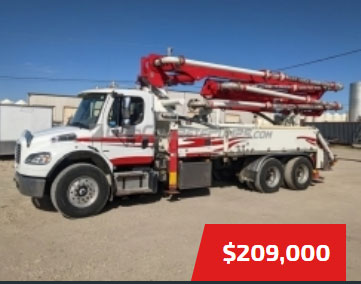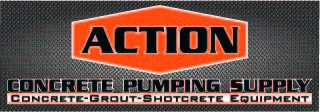Hose Hazard!
By Rob Edwards
Published by http://www.ConcretePumping.com
Double-ended hoses (also known as concrete delivery hoses) hanging from a boom, are a significant hazard to those around the hose. Consider that an end hose (single-ended hose) full of concrete weighs up to 376 pounds. In the case of a hose-whipping event, the hose can go from hanging vertically to shooting horizontally in 0.3 seconds or less, depending on how compressed the air inside the hose has become before it’s released. If you don’t know what a hose-whipping event looks like, click on the hose whip video and have a look: Hose whip video
A concrete delivery hose (double-ended hose) weighs even more than an end hose, and has a mass of steel with square corners at the end. Add another steel device such as a double-S elbow to the end of that hose, plus a clamp, and you can really get some mass involved with the hose-whipping hazard.
See Figure 1. That figure, taken on a bridge job in Kansas, depicts the hazard clearly. Picture that device moving from vertical to horizontal orientation in less than a third of a second. Picture a person in the way of the movement. It can be, and has been, deadly.
Figure 1 Showing a Concrete Delivery Hose and attached double-S elbow hanging from a boom.
Unfortunately, the double-S elbow is required on state bridge jobs in Kansas and in Illinois, perhaps in a few other places that I don’t know about. The rule, imposed by D.O.T. people in those states, is to prevent loss of entrained air by letting the concrete free-fall. It has been proven that if concrete is allowed to free-fall a significant distance, many of the tiny entrainment bubbles will pop, which means you won’t have the same entrained air percentage at the point of placement that the engineer required when he designed the bridge Figure 1 Showing a Concrete Delivery Hose and attached double-S elbow hanging from a boom.
Figure 2 If the hose whips now, serious injury will result.
Figure 3 Every person in this photo is within the range of a whipping hose, and it s fourteen stories to the street
It’s possible that the contractors in Illinois (where the film was made) are used to having a double-S elbow on the end of their hoses because of the bridge-deck regulations, so they required it of the pumping contractor on the televised project. Regardless of the reasons, it must be pointed out that this is a safety violation and should not be tolerated by anyone. The head mucky-muck at Illinois D.O.T. will go home to dinner tomorrow, even if three workers are killed by a hose whipping made markedly more severe by the device added by his rule. He probably wouldn’t even be aware of his part in their death. (Editor's note: Illinois DOT has recently reviewed these requirements and is taking steps towards removing them.)
The pumping industry has taken a stand regarding many hazards. Powerlines, for example, are known by everyone to be a very real hazard. If a job superintendant tells you to unfold your boom under powerlines, you’d just say no. If he can find somebody else to do the job, then he’s just found somebody who doesn’t mind dying or killing somebody else today. Sooner or later, the industry must take a stand on hanging concrete delivery hose from the boom and attaching a double-S to it. We KNOW it can kill people, how can we justify it?
Nobody wants to be the person who loses the job on the bridge deck in Illinois, especially in these economic hard-times. But what if you said no, and the accident lawyer tulare county job superintendant called the next company and they also said no? Then a third company would be called, and a fourth, and what if they ALL said no? Would contractors stop using pumps? Of course not. They’d change the rule. Would the first company, the one that said ‘no’ first, get the work back? Probably not, and therein lies the problem.
While the industry ponders how to proceed, there are some things operators and owners can do that would make a difference:
• Make sure people stand away from the point of placement whenever air is in the system (see the bulletin on hose whipping, available from the ACPA website);
• NEVER volunteer to add the double-ended hose or double-S elbow;
• Offer another method keeping the concrete from falling. For example, if the tip section of the boom is positioned horizontally or even slightly upwards, then the concrete would only fall the length of the end hose;
• If you pump fast enough that concrete is being forced from the hose, it will never fall. How fast you can pump is not always up to the operator, though;
• Reducing hose is more effective than double-S elbows at stopping free-fall, and has no second steel end. It accomplishes the goal without adding the hazard;
• If you’re using one of these methods to reduce loss of air entrainment, ask the job superintendant to take the air readings at the point of discharge; he may not require the double-S if the air loss isn’t happening.
Link To PDF for viewing and printing In PDF formatt
©2009, Robert Edwards























.jpg)
.gif)

.jpg)








.jpg)









